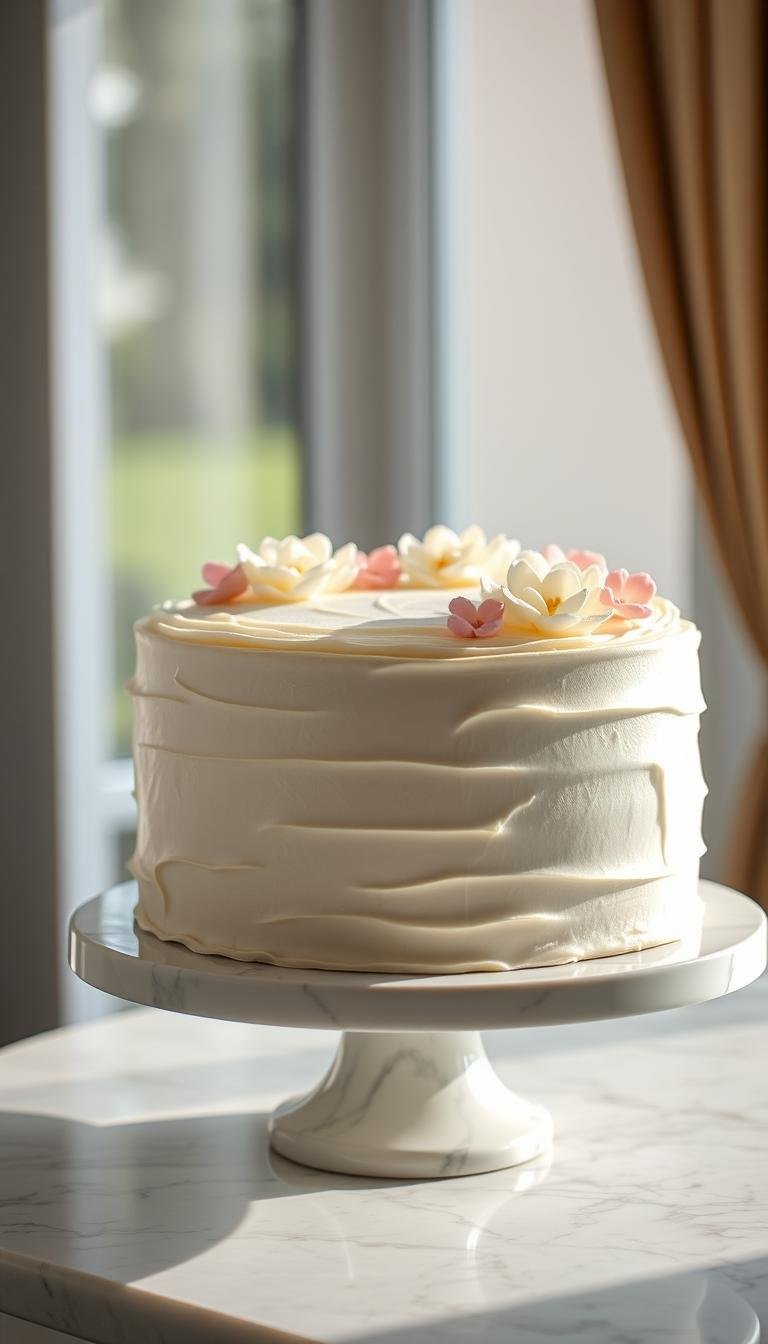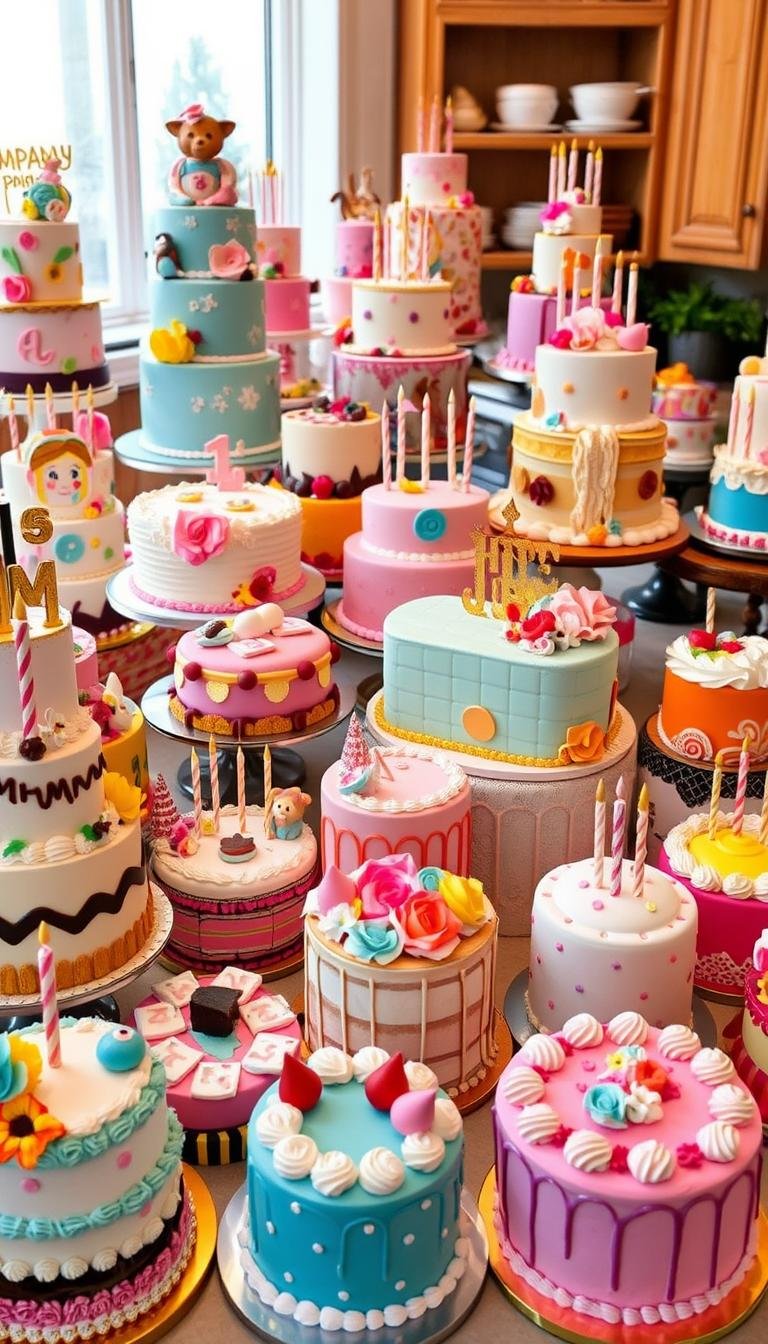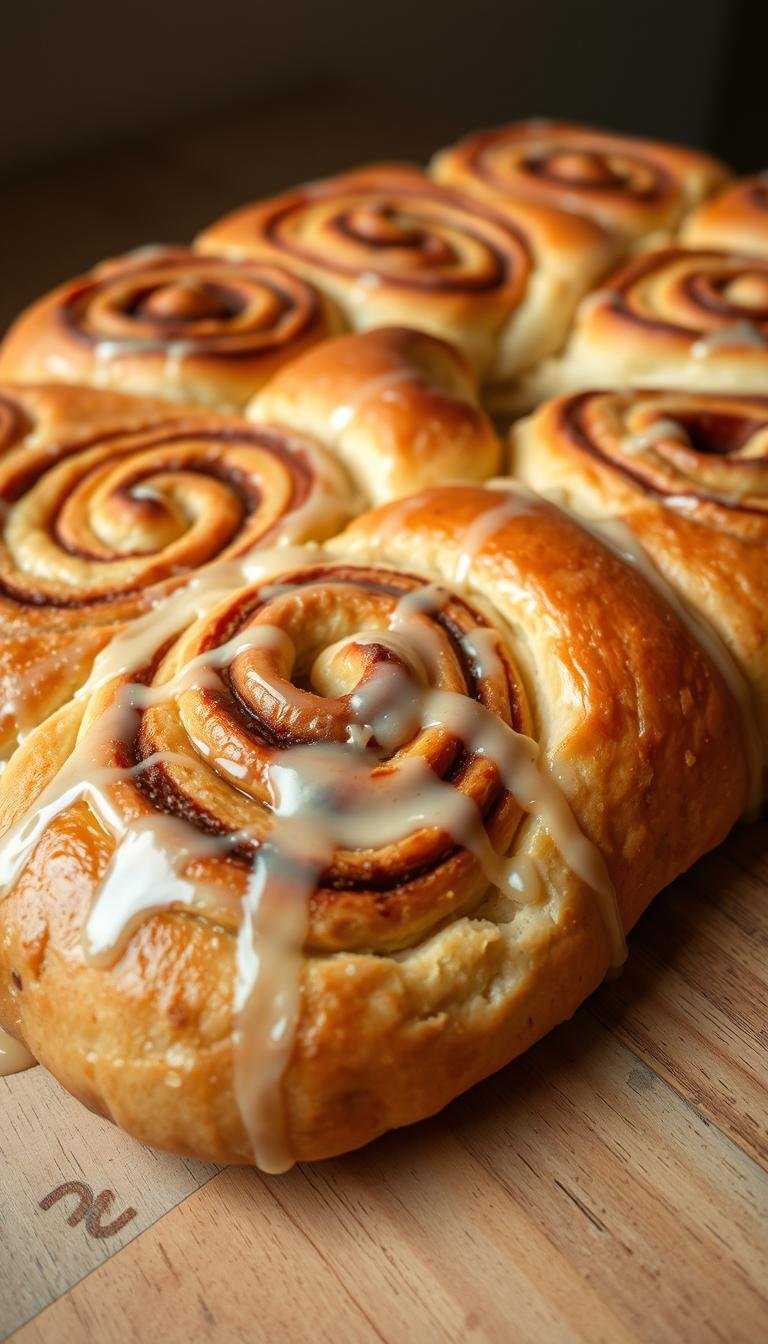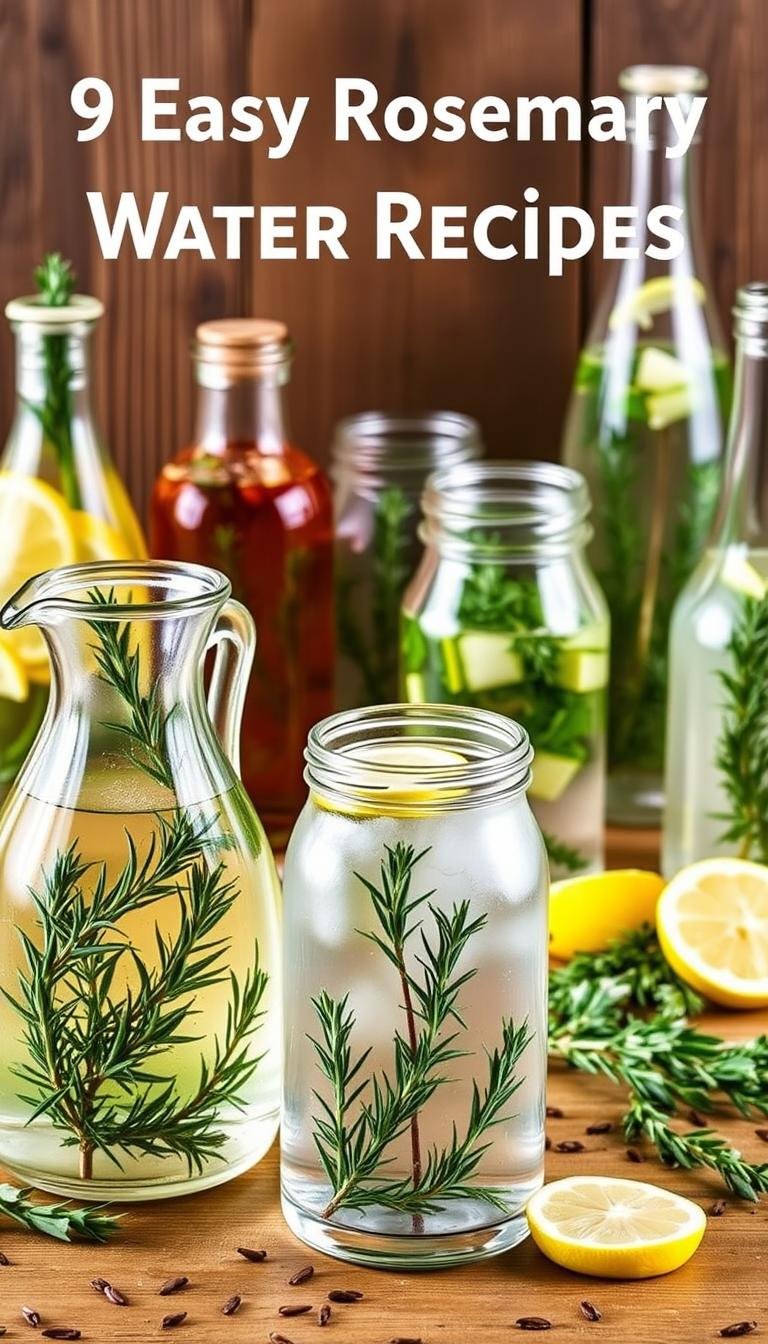Classic White Birthday Cake Recipe for Celebrations
Did you know professional bakers report that using only egg whites can cut interior color tint by over 90%, producing a truly pale layer that looks like fresh snow.
This guide explains a classic white cake recipe that yields tender layers and a clean vanilla flavor. You will learn to bring ingredients to room temperature, cream butter and sugar until light, and fold whipped egg whites into the batter for lift.
We rely on cake flour and a bit of sour cream for softness and moisture. Expect reliable bake times—two 9-inch pans at 350°F about 24–25 minutes—and simple tips for parchment-lined pans, accurate weighing, and testing doneness with a toothpick.
Follow this recipe for bakery-style layers, a stable buttercream crumb coat, and a subtle vanilla finish that suits celebrations and layered desserts.
Key Takeaways
- Color & texture: Use only egg whites and cake flour for a pristine crumb.
- Method: Cream butter and sugar, mix in dry ingredients, then fold in beaten whites.
- Timing: Bake at 350°F; pans and size affect minutes needed.
- Tools: Scale, mixer, parchment rounds, and oven thermometer improve results.
- Finish: Apply a crumb coat and chill 20–60 minutes before final frosting.
Why This White Cake Belongs at Every Celebration
When you want a tender, neutral-flavored layer that lets frosting shine, this rendition fits the bill.
Soft, moist crumb with pure vanilla flavor
Using cake flour produces a delicate crumb that feels light but still slices cleanly. Sour cream adds moisture without weighing the batter down, so each bite stays tender.
Relying on only egg whites keeps the interior very pale and prevents any eggy flavor from competing with vanilla. Five to seven whites are typical depending on egg size and yield.
From-scratch ease with bakery-quality results
Thoroughly creaming butter and sugar traps air to support rise and a fine texture. Bring all ingredients to room temperature so the batter emulsifies evenly in the bowl and bakes predictably across pans.
Pure vanilla extract gives dependable depth; clear vanilla can preserve a whiter hue if you prefer. The method—cream, add whites, fold in dry ingredients and milk—fits into tight party timelines measured in minutes.
- Reliable ingredients: common pantry items deliver professional results without special tools.
- Frosting ready: buttercream complements the delicate vanilla and provides a smooth finish for decorations.
Ingredients and Tools You’ll Need
Successful baking begins with mise en place: measured ingredients, calibrated tools, and room-temperature components.
Key ingredients include cake flour (about 295 g for two 9-inch layers), granulated sugar, baking powder, a pinch of salt, and 5 large egg whites. Add ~120 g full‑fat sour cream, 240 ml whole milk, unsalted butter, 1 Tbsp pure vanilla extract, and a touch of neutral oil if you like extra tenderness.
Room temperature checklist
- Butter should press easily but not look greasy.
- Milk and sour cream should be cool‑room so they blend smoothly.
- Egg whites should be near room temperature to whip fully.
Essential tools are two 9‑inch cake pans (Fat Daddio’s or Wilton recommended), parchment rounds, an electric hand or stand mixer, a silicone spatula, a reliable kitchen scale, and an oven thermometer set to confirm 350°F.
“Make sure bowls and whisks are clean and grease-free so egg whites whip to full volume.”
Prep tip: Line and grease pans — grease, parchment, grease again, then lightly flour — and set aside measured dry and wet bowls. That saves minutes and helps you fold whites into the batter without overmixing.
white birthday cake: Pro Tips for a Fluffy, Snow-White Crumb
Professional results come down to two things: whipped whites and well‑aerated butter for stable lift. These pro tips focus on simple, high‑impact steps that protect color and texture.
Use only egg whites and fold gently for lift
Beat egg whites in a spotless, grease‑free bowl with a clean mixer until they hold stiff peaks. Stop just before they dry out.
Fold the whites into the batter by hand with broad strokes, turning the bowl and scraping the bottom until streaks vanish. This keeps air in the mixture and preserves volume.
Cream butter and sugar properly for structure
Cream butter and sugar 2–3 minutes until light and slightly paler. That trapped air works with baking powder to lift the layers.
Make sure all ingredients are at room temperature so the batter emulsifies evenly and bakes without tunnels.
Cake flour vs all-purpose: when to substitute and how
Prefer cake flour for a tender crumb. If you only have all‑purpose flour, remove 2 tablespoons per cup and replace with cornstarch, then sift twice to mimic cake flour.
Clear vanilla vs pure vanilla: flavor and color considerations
Pure vanilla extract adds depth of flavor. Clear vanilla keeps the interior paler. Choose based on whether color or complex flavor is your priority.
“Avoid egg yolks entirely for this style; even a small amount adds color and extra fat that can weigh down the final cake.”
Step-by-Step: Make the Batter Like a Pro
Start here for a straightforward workflow that turns simple ingredients into an airy, stable batter.
Prepare pans and preheat
Preheat the oven to 350°F. Grease two 9‑inch cake pans, press in parchment rounds, grease again, then dust lightly with flour. Place pans on the center rack for even baking time.
Mix wet ingredients
Cream butter with sugar in a mixer about two minutes until pale and fluffy. If using oil, blend it with the butter first so the fat phase is uniform.
Add vanilla extract and sour cream to the bowl and mix until just combined. Keep ingredients at room temperature for a smooth, lump‑free mixture.
Alternate dry and milk
Whisk cake flour, baking powder, and salt separately. Add dry and milk to the batter in alternating additions, starting and ending with dry. Scrape the bowl; stop when only tiny streaks remain to avoid overmixing.
Beat whites and fold
In a clean bowl, beat egg whites to stiff peaks. Fold the whites into the batter in two additions with broad strokes to keep air in the mixture.
| Step | Time (minutes) | Key tip |
|---|---|---|
| Preheat & prep pans | 5–10 | Grease, parchment, grease, flour for clean release |
| Cream butter & sugar | 2 | Mix until pale; uniform fat phase if oil used |
| Alternate dry & milk | 2–3 | Begin and end with dry to prevent curdling |
| Beat whites & fold | 3–5 | Fold gently in two additions; preserve volume |
Divide the cake batter evenly by weight and bake: two 9‑inch rounds ~24–25 minutes, two 8‑inch 35–40 minutes, cupcakes ~18 minutes. Test with a toothpick; remove when it comes out clean or with a few moist crumbs.
Baking and Doneness Cues
Proper pan fill, rotation, and visual checks take the guesswork out of baking perfect layers.
Pan sizes, fill levels, and rotation
Fill each pan about two‑thirds full so batter rises without spilling. Weigh or divide batter evenly to reduce doming and uneven centers.
Place cake pans on the center rack and rotate once if your oven has hot spots. Keep all pans on one level so air flows evenly.
Doneness cues and cooling
Watch for a subtle golden edge and a set center while the interior stays pale thanks to egg whites and cake flour.
Start checking a few minutes early. Insert a toothpick into the center. Remove the pan when the toothpick comes clean or with a few moist crumbs.
Cool in the pan on a rack for 10–60 minutes depending on the recipe, then invert and cool completely before frosting to protect delicate layers.
| Pan size | Typical time (minutes) | Quick tip |
|---|---|---|
| Two 9‑inch rounds | 24–25 | Divide batter by weight; rotate halfway |
| Two 8‑inch rounds | 35–40 | Deeper pans need more time; check early |
| General | — | Use an oven thermometer to confirm temperature |
“Even batter distribution and correct temperature prevent gummy centers and overbrowned edges.”
Frosting, Filling, and Layer Assembly
Finish each layer with a complementary frosting and a simple filling to highlight the delicate vanilla notes.
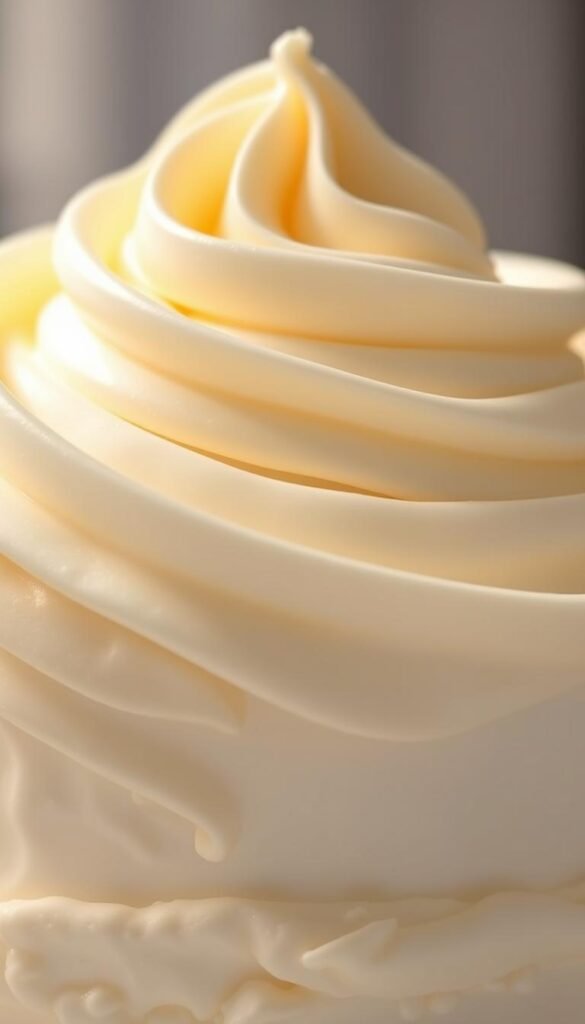
Choose your frosting
Select a frosting that complements the pale crumb: classic vanilla buttercream for a bakery look, chocolate for contrast, or whipped frosting for a lighter finish.
Make a silky buttercream
Beat butter until creamy. Add confectioners’ sugar, heavy cream, vanilla extract, and a pinch of salt.
Whip about three minutes until smooth and stable. This provides structure and a balanced flavor for stacking.
Assemble and crumb coat
Level each layer if needed, then spread 3/4–1 cup frosting between layers. Pipe a buttercream dam and add ~1/4 cup fruit preserves per layer to prevent sliding.
Apply a thin crumb coat and chill 20–60 minutes to set. Work at room temperature for easy spreading, then chill if the mixture softens.
- Use an offset spatula and bench scraper for clean edges.
- Rotate on a turntable for even pressure and alignment.
- Finish with piped borders or simple decorations so the white cake layers remain the star.
Pan Conversions and Yield: 8-inch, 9-inch, 9×13, Bundt, and Cupcakes
Convert this recipe cleanly by measuring total batter volume and matching it to your pans.
How to adjust bake time and portion sizes
Two 9‑inch rounds use about 7 cups of cake batter and bake ~24–25 minutes at 350°F. Fill pans two‑thirds full to avoid overflow.
Two 8‑inch rounds need longer, about 35–40 minutes, since they are deeper. Use three 8‑inch pans for thinner layers that finish faster.
When to split or scale the batter
For a 9×13 pan plan ~38 minutes and cool before slicing. A 10–12 inch Bundt holds the full mixture; test early with a toothpick to judge doneness.
For cupcakes, fill liners 2/3–3/4 full and bake about 18 minutes. Split the batter across batches to avoid crowding the oven and to keep even temperature and rise.
| Format | Fill level | Typical minutes | Servings |
|---|---|---|---|
| Two 9‑inch rounds | 2/3 full | 24–25 | 12–16 wedges |
| Two 8‑inch / three 8‑inch | 2/3 / 2/3 | 35–40 / faster | 12–18 |
| 9×13 pan | Spread evenly | ~38 | 12–20 rectangular slices |
| Bundt / Cupcakes | Full / 2/3–3/4 | Start early / ~18 | 10–12 Bundt slices / 12–24 cupcakes |
“Work backward from serving time to schedule cooling, crumb coat chilling, and final frosting.”
Tip: Keep the oven at the same temperature and watch minutes closely; changes in pan depth influence heat flow and final layer height. This helps your vanilla layers finish with consistent texture and color when baking for events.
Success Tips, Troubleshooting, and Make-Ahead Storage
Control the small details and you’ll avoid most problems that derail a cake recipe.
Prevent dense layers
Weigh flour for consistent results. If you don’t have a scale, spoon and level each cup to avoid packing and excess flour that tightens the crumb.
Beat egg whites until stiff, then fold them gently in two additions. Aggressive stirring collapses air and makes dense layers.

Temperature control
Bring eggs, milk, butter, and sour cream to room temperature so the batter emulsifies evenly. Place eggs in warm water for 10 minutes and briefly warm milk or cream if needed.
Use an oven thermometer to verify the set temperature at 350°F; small offsets change bake time and texture.
Make-ahead and storage
Bake and cool layers fully, then wrap each tightly. You can hold unfrosted layers at room for up to 24 hours.
Refrigerate a frosted cake 3–5 days. For longer storage, freeze up to two months; thaw in the refrigerator and let the cake come to room before slicing.
| Issue | Cause | Quick fix |
|---|---|---|
| Dense crumb | Packed flour or deflated whites | Weigh flour; fold whites gently |
| Gummy center | Low oven temperature or underbake | Check oven thermometer; bake until toothpick comes clean or with few moist crumbs |
| Runny frosting | Warm layers or thin buttercream | Chill layers; add more confectioners’ sugar or a dash of salt to buttercream |
“Make sure to plan time for cooling, crumb coat setting, and final frosting so your layers stay stable.”
Conclusion
Finish confidently by focusing on doneness cues, a quick chill, and neat assembly.
This recipe hinges on only egg whites for pale crumb, cake flour for tenderness, and proper creaming for structure. Keep ingredients at room temperature so the batter stays stable and bakes evenly.
Confirm doneness with a toothpick and visual cues, then apply a thin crumb coat and chill briefly before final frosting. Use tested timings for two 9‑inch, two 8‑inch, 9×13, Bundt, or cupcakes and adjust minutes for pan depth.
Follow these instructions and you’ll have a reliable white birthday cake with gentle vanilla flavor and smooth buttercream ready to serve or freeze for later.
